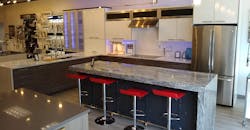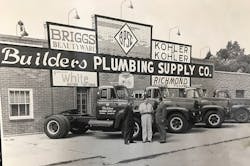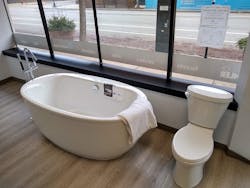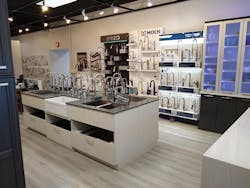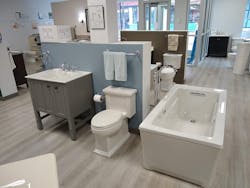CHICAGO—At 97 years of age, Sig Feiger is still active in the business today. Founded in 1948, Feiger started Crawford Supply with little money and a whole lot of determination, traveling across the Midwest to places like North Platte, Nebraska to sell material. “Excluding the winter months when he works remotely, Sig is typically still in the office three or four days a week,” says Micky Raker, general manager, Crawford Supply. It is with that perseverance, along with a solid team in place, that has grown the company today to be one of the most successful supply houses in the Chicagoland area, with an additional two branches in Michigan and Pennsylvania.
In Michigan there are three branches branded as Builders Plumbing & Heating Supply and there are four branches in the Pittsburgh area branded as Plumbers Equipment.
Interestingly, when the company was founded in ’48, Crawford Supply was Builders Plumbing & Heating Supply, and when the Sig and his original partner parted ways, the company was rebranded and divided geographically, and the name Crawford Supply came through an acquisition. Today, the company is in the capable hands of Sig’s son Steve, president and CEO, and Jeff Heksh, COO.
Over the duration of those 72 years, the showroom side of Crawford’s business—with the number of showrooms and the presence in different markets remaining fluid over time—has always been dedicated to the trades. “Since the majority of our business is trade-driven, we view the showrooms as an extension of our customers’ businesses and an additional resource for them and their clientele to use,” says Raker.
The showrooms, like many other supply house showrooms, are open to both contractors and consumers, and holding steady to its mantra of being a trade-driven organization, once those end users retain a contractor for their project, the contractor is typically who steers them to the showrooms. “However, over the course of the last 19 years that I have been with Crawford Supply, the definition of ‘trade’ has evolved significantly. We now embrace builders, developers, remodelers, interior designers, and architects, as well as plumbers and HVAC contractors, as trade professionals,” adds Raker.
Most of Crawford’s showrooms, excluding its Chicago branch, are not very visible to the general public. Therefore, the company relies on its trade customers to drive showroom traffic and its outside sales team to capture new trade customers on an ongoing basis. “On the rare occasion that we do have a truly retail customer visit our showroom, we provide them with a list of suggested contractors based on our existing relationships and the geography of the project,” says Raker.
As a result, almost everything that Crawford does as an organization is done around contractor needs and a process to add value to their respective businesses. Whether it is providing professional guidance in terms of the selection process, providing product specifications to the contractor once selections have been made, deciding what the inventory should look like, pricing, or after sales service related to installation assistance or warranty facilitation, Crawford does it with the contractor in mind. The goal is to make their jobs easier and thereby their respective business more profitable.
According to Raker, “Most contractors are good at identifying the scope of a project, yet they can struggle when it comes to guiding their customers through the selection process, which is where our showrooms and our staff come in. The ongoing showroom traffic has helped drive sales, enhance margins and create a customer experience that leads to future referrals.”
Led by showroom manager, Dario Cazares, the showroom consultations can look significantly different depending on the contractor and/or the project type. However, everything typically starts when the contractor is retained. The contractor typically directs the customer end user to one of the showrooms, preferably with an appointment. Sometimes they come on in with detailed building plans for new construction. Sometimes they are just in need of a replacement toilet or faucet. Either way, Crawford immediately identifies the contractor with whom the customer is working and work on clarifying the scope of the project.
Crawford also tries to establish a budget or an allowance very early on, says Raker, and once all of that that is established, Cazares and his showroom staff guide the homeowner through the selection process. Throughout the selection process, the showroom team tries to establish some realistic expectations in terms of things like pricing and lead times to ensure that it is creating a package that is going to work for all parties involved.
The rest depends on the situation. “Sometimes people are replacing a faucet or fixture that we may have on the shelf so there is only one touch. They make a decision, purchase a product, and either leave our showroom with what they need or we deliver it the next day on our truck. However, more often than not, there is more involved. Many of the projects that we are involved in require multiple visits to the showroom and may involve multiple people—a spouse, or third-party designer,” says Raker.
To help keep things on track, staff often provides an electronic spec book that includes product images, specifications and sometimes pricing. “We also try to keep the contractor in the loop on all changes to avoid any unforeseen problems. Once all of the selections are made, we order the product and schedule deliveries—usually with the contractor—as needed. Where appropriate, we also try to follow up with homeowners shortly after a project is delivered to ensure satisfaction with the overall experience,” says Raker.
SIDEBAR
Recently, in light of the recent COVID-19 pandemic, the U.S. Department of Homeland Security Cybersecurity and Infrastructure Security Agency (CISA) has updated its “Essential Critical Infrastructure Workforce” advisory list to more accurately define the plumbing and mechanical industry, and workers who support the supply chain of building materials from production through application/installation, including plumbing, electrical, heating/cooling and refrigeration, and employees who provide services that enable repair materials and equipment for essential functions, have been added to that list.
While Crawford Supply’s showroom is currently closed, the supply house is still open for business, but no longer allowing anyone—other than current employees—into its buildings, and the will-call business has shifted to parking lot drop-offs. From cleaning and sterilizing work areas to keeping ample hand sanitizer to practicing social distancing, “We have been very proactive during this process, and we have done a very good job at taking the necessary precautions to keep our employees safe,” says Raker.
YouTube video
https://www.youtube.com/watch?v=npBmJifuh38&feature=youtu.be
